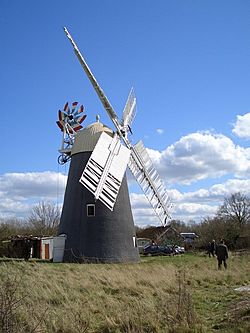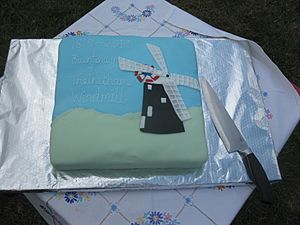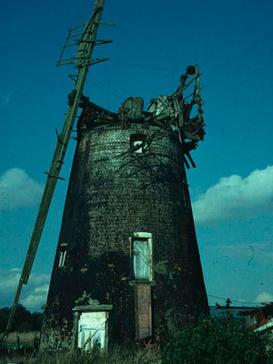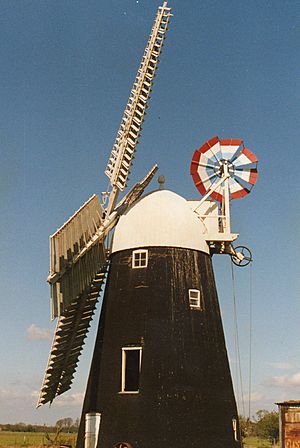Thelnetham Windmill facts for kids
Quick facts for kids Thelnetham Windmill |
|
|---|---|

The restored mill, photographed in 2006
|
|
| Origin | |
| Mill name | Button's Mill |
| Mill location | TM 011 790 |
| Coordinates | 52°22′19″N 0°57′18″E / 52.37194°N 0.95500°E |
| Operator(s) | Thelnetham Mill Preservation Trust |
| Year built | 1819 |
| Information | |
| Purpose | Corn mill |
| Type | Tower mill |
| Storeys | Four storeys |
| No. of sails | Four sails |
| Type of sails | Double Patent sails |
| Windshaft | Cast iron |
| Winding | Fantail |
| Fantail blades | Eight blades |
| Auxiliary power | Originally a Portable steam engine, then an oil engine, now a Ruston & Hornsby diesel engine |
| No. of pairs of millstones | Two pairs driven by wind, plus one pair driven by engine |
| Size of millstones | 4 feet 4 inches (1.32 m) and 4 feet 7 inches (1.40 m) diameter. Engine driven stones 4 feet 6 inches (1.37 m) diameter. |
| Other information | Oldest surviving tower mill in Suffolk. |
Thelnetham Windmill, also known as Button's Mill, is a special old brick windmill. It's a "Grade II* listed" building, which means it's very important historically. You can find it in Thelnetham, Suffolk, England. It was built a long time ago, in 1819, to grind wheat into flour.
This windmill used wind power until 1924, even though it only had two sails left by then. After that, it fell into disrepair. In 1979, some people who loved windmills bought it to fix it up. Many volunteers worked for eight years to make it work perfectly again. Today, the mill is open to the public, and you can even buy flour ground right there!
The mill is a small, four-story tower mill. It has special "Patent sails" and uses a "fantail" to turn itself into the wind. It can power two pairs of millstones, and a third pair can be run by a separate engine.
Contents
History of Thelnetham Windmill
The very first record of a windmill in Thelnetham was a "post mill" shown on a map from 1778. In 1818, this old post mill was moved to a different location.
Building the Tower Mill
A new tower mill was built in its place by a mill builder named George Bloomfield for William Button in 1819. The mill started working on Christmas Day that year. In 1832, the mill was updated with a strong cast-iron "windshaft," new Patent sails, and a fantail. The new windshaft was installed in July 1832 and weighed about 1,780 kilograms (almost 2 tons!).
William Button passed away in 1837. The mill then belonged to his wife Rebecca and their son Richard. Richard Button worked the mill until 1860. Later, it was sold to Richard Peverett in 1862.
Changes Over the Years
Stephen Peverett, Richard's son, took over the mill. He inherited it in 1875 and later leased it to Henry Bryant in 1879. In 1884, Henry Bryant bought the mill and rebuilt its floors.
From 1892, a portable steam engine was used to help grind grain, powering an extra pair of millstones. This was replaced in 1914 by an oil engine. Henry Bryant ran the mill until 1920 when he sold it to Alphonso Vincent. The oil engine was sold in the early 1920s. Around 1920, the mill was damaged by strong winds from behind, so one pair of sails had to be removed. Alphonso Vincent made some repairs and ran the mill until he retired in 1924. Another sail was destroyed in 1926 by more strong winds.
Becoming Derelict and Plans for Restoration
When Alphonso Vincent died in 1932, his son George inherited the mill. George lived on the site in an old lorry until he passed away in 1973. His daughter then sold the mill in 1974 to a couple who wanted to turn it into a house. However, they changed their minds and decided to sell it for restoration.
In 1976, a strong storm blew the top (cap) of the mill to pieces. In November 1979, five members of the Suffolk Mills Group bought the mill for £6,000. They made plans to restore it.
In 2013, the mill was given to the Suffolk Building Preservation Trust. This trust also owns another historic mill, Pakenham Watermill. On July 14, 2019, the windmill celebrated its 200th birthday! The old lorry that George Vincent lived in, now fully restored, was even there for the celebration. In 2019, the mill was also used as a polling station for elections because the usual village hall was being renovated.
Restoring Thelnetham Windmill
The mill was restored over six years, mostly by volunteers. They used their holidays to work on repairing the mill.
Early Restoration Work (1979–1980)
The new owners took over the mill in November 1979. Their first job was to make the mill waterproof. They put plastic sheets on the top floor to stop water from getting in. The mill was carefully checked and recorded. In spring 1980, part of the top floor collapsed and was removed for safety. Scaffolding was put up to take down the "fanstage" and cap parts.
A two-week "work-in" was held in July and August 1980. Thirty-three volunteers helped. They made two new main floor beams from old wood. On August 3, 1980, a crane removed the windshaft and broken sail pieces, then the cap frame and other parts.
New wooden "joists" were put on the top floor, and temporary boards were laid for a working platform. The "bin floor" was removed, except for one main beam that could be fixed. New joists were fitted, some from the original floor and some from another old windmill. The "sack hoist" was taken apart for repair. Brickwork was fixed, and new window frames were made. A large tarp was put over the mill tower for the winter. The bin floorboards were replaced, and one pair of millstones was removed.
This early work was paid for by grants and donations. The "work-in" was even reported on TV and in newspapers!
More Repairs (1981)
In 1981, two more "work-ins" were held, with 37 volunteers helping. The millstones were removed from the "stone floor," which was then repaired. One main beam had been damaged by beetles, so a third of it was replaced with new wood. The supports for the "hurst frame" were fixed one by one.
The new main beam for the stone floor was installed, and the ground floor was concreted. The stone floor was rebuilt using old and new wood. New floorboards were laid on the top two floors. The top four layers of brickwork on the mill tower were removed and rebuilt. The windshaft and other metal parts were painted to protect them. A new decorative top piece for the cap was made from oak. Workers also started fixing the mortar between the bricks.
After the work-ins, the stone floor was finished, and the mill was cleaned for an open day. The work in 1981 cost £3,250, with grants from various organizations. The project also got more attention from local media.
Cap Construction (1982–1983)
Work in 1982 focused on finishing the brickwork, installing the "curb" (a circular track), and starting the new cap. The cap frame was built, using some parts from the original cap. It was built upside down, then a crane turned it over and put the windshaft in place.
In early 1983, smaller jobs were done, like fixing brass parts and overhauling the fantail and sail control mechanisms. The mill was made safe for visitors. Work also included fixing the drive for one of the millstones.
When the weather improved, outdoor work began. The cap circle was mostly built before the first work-in in July. During the work-ins, the fantail posts and cap ribs were fitted. The cap frame was completed, and the back of the cap circle was finished.
Between the work-ins, the rear dormer window was completed. This allowed workers to start boarding the cap. The cap boards were thin and tapered. A new "neck bearing" was installed under the windshaft. Once the cap was boarded, cover strips were fitted. The "petticoat" (bottom edge of the cap) was pulled into place and reinforced with a steel band. The "striking rod" (for controlling the sails) and fantail axle were fitted. The curb on the tower was prepared for the cap, and the cast-iron track plates were bolted down. Repointing the brickwork continued.
After the work-ins, work continued to finish the cap for its lift-on in October. A special paint was used to protect the timber. A mini work-in was held the weekend before the cap lift. The 5-ton cap was lifted into place by a crane on October 24, 1983, with about 70 people watching. The fitting of the cap was celebrated with local beer.
Restoration work in 1983 cost £1,408, with grants from various groups and income from guide books.
Sails and Fantail (1984)
Four work-ins were held in 1984. Two were by apprentices from Eastern Electricity Board, who helped as part of a development project. A main electricity supply was installed at the mill, with underground cables laid with help from British Telecom. This gave the mill lights and power sockets on each floor.
The apprentices also repaired frost damage to the foundation bricks, dug a drainage trench around the mill, and moved the auxiliary engine into place. A new "French drain" was built to fix damp problems. A 21-horsepower diesel engine, bought in 1981, was installed on a concrete base and painted.
Off-site, the new "brake wheel" and fantail were made. The original brake wheel was too rotten. The new brake wheel was designed to be like the original one from 1819 but with cast-iron teeth. The old brake wheel parts were kept as an exhibit. The fantail was also made, with new gears and blades painted red, white, and blue.
Over the winter, brickwork and windows were repaired. New wooden "cogs" were fitted to the "crown wheel."
The "stocks" (main beams for the sails) and sails were made during two work-ins in July and August, with 41 people helping. Two new laminated stocks were needed because good quality solid timber was hard to find. Laminated stocks are stronger than solid ones. The 52-foot-long stocks were made from treated Douglas fir.
The four sails were also made. The new sails were made identical, at a larger "pitch." Four 27-foot-long "whips" (main sail spars) were cut from old timber. Sail bars and "uplongs" were made from new wood. Three of the four sails were completed by the end of the work-in.
The fantail and its gears were fitted to the mill. By the end of the second work-in, the cap could be turned by hand. The "clasp arm brake wheel" was assembled around the windshaft. The "wallower" (a gear) was found to be slightly off-center but was corrected. The clamps for the stocks were cut. Other work included a new door frame and painting ironwork.
The four sails were fitted to the mill with a crane at the end of the second work-in. The mill turned by wind again on the last day of the work-in! Later, the fourth sail was finished, the fantail was balanced, and the brake and "shutter cranks" for the sails were installed.
Restoration work in 1984 cost £2,918, with grants from English Heritage and other donations. A large donation of £2,000 from Hervey Benham helped a lot. The project also received more media attention, including a feature on a TV program.
Finishing Touches (1985–1987)
Work planned for 1985 included replacing the dust floor window and finishing the stocks and sails. The outside walls of the mill were tarred, and the inside walls were plastered. Two work-ins were held. More work over the next two years saw the restoration completed in 1987.
The Restoration Team
The restoration of Thelnetham Windmill was a huge team effort! It was made possible by 135 individuals and 61 organizations. They helped by donating their time, equipment, materials, or money, or by giving discounts on materials.
Description of Thelnetham Windmill
The four-story tower is made of brick and stands about 9.5 meters (31 feet 5 inches) tall from the ground to the top edge. The walls are 600 mm (2 feet) thick at ground level.
The Cap and Sails
The "pepperpot cap" sits on top of the tower, making the mill about 13.7 meters (45 feet) tall to its very top. Inside the cap are the cast-iron "windshaft" and the 2.18-meter (7-foot-2-inch) wooden "brake wheel." Outside, the four "double Patent sails" stretch 19.5 meters (64 feet) wide. They are 2.7 meters (9 feet) wide and can produce 30 horsepower. The eight-bladed "fantail" automatically turns the mill to face the wind.
Inside the Mill
- Dust Floor: This is the top floor. It was used for storing grain and gives access to the cap. The cast-iron "wallower," driven by the "brake wheel," is at the top of the "upright shaft" in the center of the mill.
- Bin Floor: This floor is where grain is stored before it's ground into flour. The "sack hoist" mechanism, which lifts sacks, is also here, powered by a belt from the "crown wheel" below.
- Stone Floor: This is where the two pairs of "underdrift" French Burr "millstones" are located. The stones are 1.32 meters (4 feet 4 inches) and 1.4 meters (4 feet 7 inches) in diameter. The wooden "crown wheel" is towards the ceiling. This powers the sack hoist. Other machines on this floor include an oat crusher and a "flour dresser."
- Ground Floor (Meal Floor): This is where the freshly ground flour comes out and is bagged. The wooden "great spur wheel" and "stone nuts" are on this floor. A third pair of 1.37-meter (4-foot-6-inch) diameter French Burr millstones is on a special frame. These are powered by the auxiliary engine.
Millers of Thelnetham Windmill
- William Button 1819-1837
- Rebecca Button 1837-unknown
- Richard Button 18??-1860
- William Button 1860-1862
- Richard Button (Jr) 1860-1862
- Stephen Peverett 1862-1879
- Henry Bryant 1879-1920
- Alphonso Vincent 1920-1924
- George Vincent 1920-1924
Culture and Media
A video about the restoration of the mill was made by Viv Codd.
Visiting Thelnetham Mill
Thelnetham Mill is open to the public on Easter Monday, the Sundays of the late May and August bank holidays, and the first Sunday in July, August, and September. You can also arrange to visit at other times.




